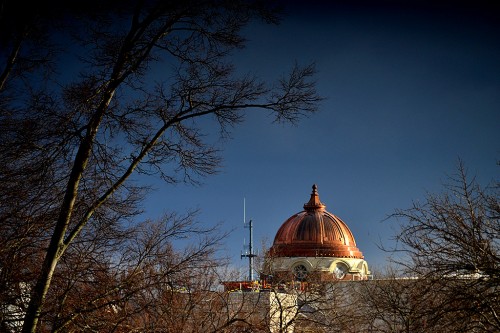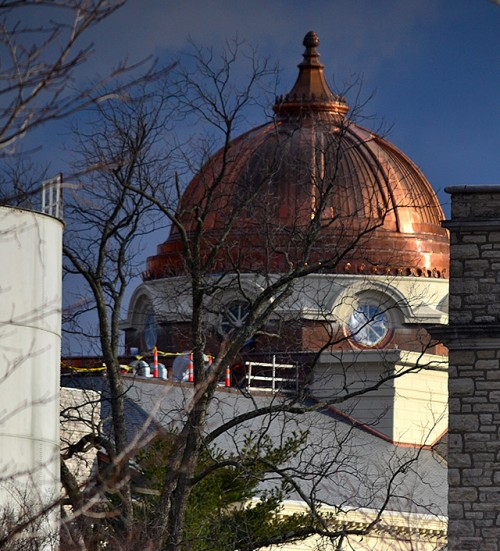 Academic Hall has been undergoing some major fixing. Surprisingly enough, the university hasn’t used “structural problems” as an excuse to tear down the iconic building as they seem so prone to do with other Cape landmarks.
Academic Hall has been undergoing some major fixing. Surprisingly enough, the university hasn’t used “structural problems” as an excuse to tear down the iconic building as they seem so prone to do with other Cape landmarks.
Here’s a view of the dome from the north, looking south. You don’t often see it from this side.
Academic Hall Stories
 Missourian webmaster James Baughn offers this information on Academic Hall.
Missourian webmaster James Baughn offers this information on Academic Hall.- Academic Hall in 1966 and 2011
- Fred Lynch had a photo of the dome with scaffolding around it.
- Dome reconstruction starts
- Vintage and current SEMO aerials and photos
- 1966 Outstanding Seniors in front of Academic Hall

I suspect the SEMO University administration is sensitive to fund-raising issues that might arise if alums were to learn that Academic Hall will be torn down.
My mother told of going up into the dome during the “great flood” of 1928 or 1929 or whenever it was back then and watching trees and houses float by in the Mississippi. There were animals trapped on the roofs of some of those houses and even people stranded on some.
It would have been the Flood of 1927, the subject of a book, Rising Tide: The Great Mississippi Flood of 1927 and How it Changed America.
I’ve read it twice: the first time I was fascinated by the account of the flood. I picked it up last month and re-read it, this time focusing on the impact it had on government programs and the politics of the river.
I’m sure I’ll read it again and find even more subplots. It’s one of my favorite books, full of scientific river lore, dirty politics and general skulduggery and greed.
I haven’t been in Academic hall since 1977 when I graduated from SEMO. I used to teach swimming in the basement next to the nursing class rooms. Down the hall in the basement across from the pool was the computer room that was managed by the late Don Krueger. AH was an old, cold, drafty building back then, however, it did then and does now have character and deserved the dome makeover should be left as a landmark.
I’m glad to see that the dome is now back to its rightful copper color. When I attended SEMO in the early 70s, it was an ornery shade of green tarnish. But every year when the Alumni Association solicited donations, those who contributed $150 or more became members of the ‘Copper Dome Society’. I used to laugh about that, but I guess no one would have donated to become members of the ‘Ornery Green Tarnish Society’.
Why do the copper roofs and domes in Europe last a hundred years when here in Cape this is the SECond time Ive seen it redune?
Laura, that green tarnish is known as “patina” and is prized by antiques people. I like both of them.
Ken, I have also read the book you mentioned about the 1927 flood.
A great book and I highly recommend it.
I also read “Rising Tide” earlier this year and thought it was a fascinating account of the flood and the culture and politics of the region. I have given copies to several friends.
Did you know that the dome was so shiny during WWII that the college was instructed to paint the dome black to avoid detection by enemy bombers. I think the whole city of Cape had to practice lights out after dark just like cities in Europe.
Brad and I took the free tour of the refurbished dome. Got to initial the support beams, look our the port hole windows and meet a pretty girl.